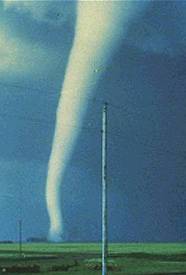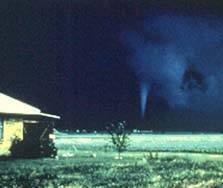FORMATION
ORIGIN OF A KILLER
Tornadoes usually form in giant rotating thunderstorms called supercells. These form when cold polar air meets warm tropical air. The result is a great instability caused by the rising warm air. A squall line (ie. narrow zone of cumulonimbus clouds forms) produces the tornadoes. Pressure inside the cloud will start to drop [Bernoulli's principle]. As it drops, it causes moisture in the air to condense. This action continues down the spiral, also giving the impression that the funnel is descending from the cloud base. In addition to the visible funnel, there is also a hissing sound, which turns deafening when the tornado touches the earth.


Tornadoes do not move normally, instead, they 'bounce', skipping over the ground at some regions, while touching them at others. This best explains why a house can be totally wrecked, but a tree close to it remains virtually untouched.
Tornadoes spin counter-clockwise north of the equator, and clockwise if located south of it. Like tropical storms, the eye of the tornado is a low-pressure zone. The winds of the tornado spins at speeds of up to 300 mph. The structure of the tornado is a cumulonimbus cloud towering on top, and a funnel connected below it.
The 'colour' of a tornado very much depends on its surroundings. If it sucks up a lot of dust, it will be dark grey, in some cases, it may suck up a lot of red soil, in that instance, it could even be red!

